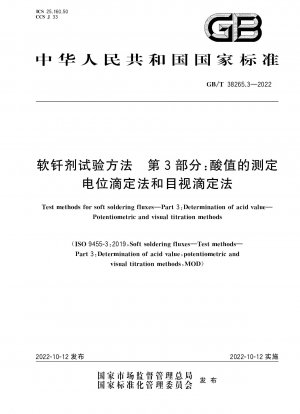GB/T 38265.3-2022
Test methods for soft soldering fluxes—Part 3:Determination of acid value—Potentiometric and visual titration methods (English Version)
- Standard No.
- GB/T 38265.3-2022
- Language
- Chinese, Available in English version
- Release Date
- 2022
- Published By
- General Administration of Quality Supervision, Inspection and Quarantine of the People‘s Republic of China
- Latest
- GB/T 38265.3-2022
- Scope
- This document specifies the determination methods for the acid value of solder—potentiometric titration and visual titration, including principles, reagents, equipment, test procedures, test data processing, precision, test reports, etc. This document applies to Type 1 and Type 2 solder fluxes defined in GB/T 15829.
GB/T 38265.3-2022 Referenced Document
- GB/T 38265.1 Test methods for soft soldering fluxes—Part 1:Determination of non-volatile matter—Gravimetric method
- GB/T 38265.2 Test methods for soft soldering fluxes—Part 2: Determination of non-volatile matter—Ebulliometric method
- GB/T 6379.2-2004 Accuracy(trueness and precision)of measurement methods and results-Part 2:Basic method for the determination of repeatability and reproducibility of a standard measurement method
- GB/T 6379.4-2006 Accuracy(trueness and precision) of measurement methods and results-Part 4:Basic methods for the determination of the trueness of a standard measurement method
- GB/T 6379.5-2006 Accuracy (trueness and precision)of measurement methods and results-Part 5:alternative methods for the determination of the precision of a standard measurement method
- GB/T 678 Chemical reagent ethanol (absolute ethanol)*, 2023-08-06 Update
- GB/T 684 chemical reagent toluene*, 2023-08-06 Update
- HG/T 2892 Chemical reagent isopropyl alcohol
GB/T 38265.3-2022 history
- 2022 GB/T 38265.3-2022 Test methods for soft soldering fluxes—Part 3:Determination of acid value—Potentiometric and visual titration methods

GB/T 38265.3-2022 -All Parts
GB/T 38265.1-2019 Test methods for soft soldering fluxes—Part 1:Determination of non-volatile matter—Gravimetric method
GB/T 38265.10-2019 Test methods for soft soldering fluxes—Part 10:Flux efficacy test—Solder spread method
GB/T 38265.11-2021 Test methods for soft soldering fluxes—Part 11: Solubility of flux residues
GB/T 38265.13-2021 Test methods for soft soldering fluxes—Part 13: Determination of flux spattering
GB/T 38265.14-2021 Test methods for soft soldering fluxes—Part 14: Assessment of tackiness of flux residues
GB/T 38265.15-2021 Test methods for soft soldering fluxes—Part 15: Copper corrosion test
GB/T 38265.16-2019 Test methods for soft soldering fluxes—Part 16:Flux efficacy test—Wetting balance method
GB/T 38265.17-2022 Test methods for soft soldering fluxes—Part 17: Surface insulation resistance comb test and electrochemical migration test of flux residues
GB/T 38265.2-2019 Test methods for soft soldering fluxes—Part 2: Determination of non-volatile matter—Ebulliometric method
GB/T 38265.3-2022 Test methods for soft soldering fluxes—Part 3:Determination of acid value—Potentiometric and visual titration methods
GB/T 38265.5-2021 Test methods for soft soldering fluxes—Part 5: Copper mirror test
GB/T 38265.6-2022 Test methods for soft soldering fluxes—Part 6: Determination of halide(excluding fluoride)content
GB/T 38265.8-2022 Test methods for soft soldering fluxes—Part 8: Determination of zinc content
GB/T 38265.9-2022 Test methods for soft soldering fluxes—Part 9: Determination of ammonia content